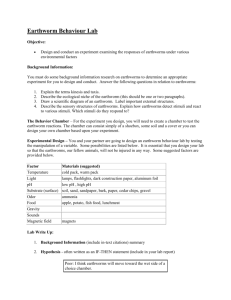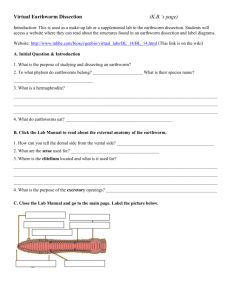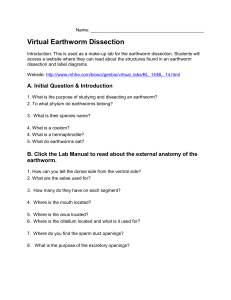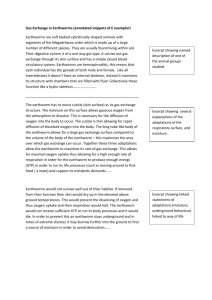Report written for: The Edna Bailey Sussman Foundation Caitlin M. Snyder
advertisement
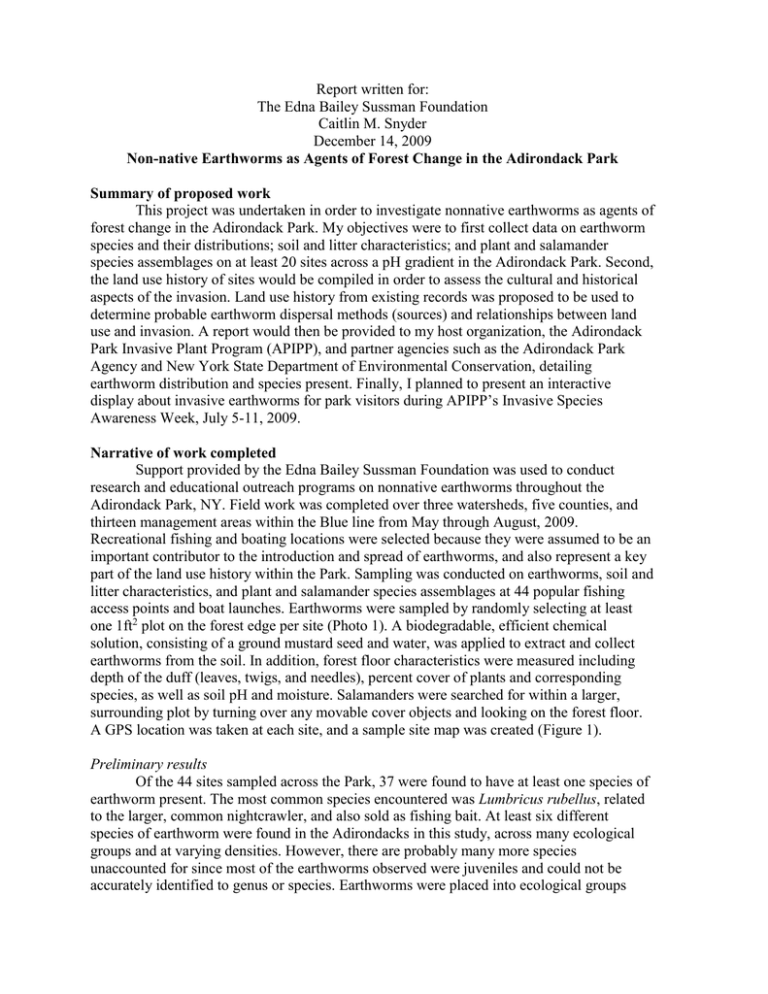
Report written for: The Edna Bailey Sussman Foundation Caitlin M. Snyder December 14, 2009 Non-native Earthworms as Agents of Forest Change in the Adirondack Park Summary of proposed work This project was undertaken in order to investigate nonnative earthworms as agents of forest change in the Adirondack Park. My objectives were to first collect data on earthworm species and their distributions; soil and litter characteristics; and plant and salamander species assemblages on at least 20 sites across a pH gradient in the Adirondack Park. Second, the land use history of sites would be compiled in order to assess the cultural and historical aspects of the invasion. Land use history from existing records was proposed to be used to determine probable earthworm dispersal methods (sources) and relationships between land use and invasion. A report would then be provided to my host organization, the Adirondack Park Invasive Plant Program (APIPP), and partner agencies such as the Adirondack Park Agency and New York State Department of Environmental Conservation, detailing earthworm distribution and species present. Finally, I planned to present an interactive display about invasive earthworms for park visitors during APIPP’s Invasive Species Awareness Week, July 5-11, 2009. Narrative of work completed Support provided by the Edna Bailey Sussman Foundation was used to conduct research and educational outreach programs on nonnative earthworms throughout the Adirondack Park, NY. Field work was completed over three watersheds, five counties, and thirteen management areas within the Blue line from May through August, 2009. Recreational fishing and boating locations were selected because they were assumed to be an important contributor to the introduction and spread of earthworms, and also represent a key part of the land use history within the Park. Sampling was conducted on earthworms, soil and litter characteristics, and plant and salamander species assemblages at 44 popular fishing access points and boat launches. Earthworms were sampled by randomly selecting at least one 1ft2 plot on the forest edge per site (Photo 1). A biodegradable, efficient chemical solution, consisting of a ground mustard seed and water, was applied to extract and collect earthworms from the soil. In addition, forest floor characteristics were measured including depth of the duff (leaves, twigs, and needles), percent cover of plants and corresponding species, as well as soil pH and moisture. Salamanders were searched for within a larger, surrounding plot by turning over any movable cover objects and looking on the forest floor. A GPS location was taken at each site, and a sample site map was created (Figure 1). Preliminary results Of the 44 sites sampled across the Park, 37 were found to have at least one species of earthworm present. The most common species encountered was Lumbricus rubellus, related to the larger, common nightcrawler, and also sold as fishing bait. At least six different species of earthworm were found in the Adirondacks in this study, across many ecological groups and at varying densities. However, there are probably many more species unaccounted for since most of the earthworms observed were juveniles and could not be accurately identified to genus or species. Earthworms were placed into ecological groups CMSnyder 2 according to their habits and characteristics: Epigeic species which dwell in the leaf litter and are pigmented and often small (e.g. Dendrobaena sp); Endogeic species which dwell in within the topsoil and are unpigmented and of varying sizes (e.g. Octolasion sp); Anecic species which dwell deep in the soil and are pigmented and usually large in size (e.g. Lumbricus terrestris, nightcrawler); Unidentified pigmented juveniles; and Unidentified unpigmented juveniles (Figure 2). Densities were highly variable due to varying degrees of recreational use and overall size of boat launches, but also probably depended on surrounding vegetation, leaf litter layer composition, and soil texture, moisture, pH, and degree of compaction, which were typically very different between the sites. Despite this variability, if certain species assemblages (e.g. a high diversity or presence of each ecological group) and high densities occur together both in time and space, then the forest floor could be negatively impacted by physical and chemical disturbances (e.g. elimination of the duff layer) caused by the action of nonnative earthworms. Data obtained regarding plants and salamanders has yet to be correlated with earthworm abundances and species assemblages. Salamanders were difficult to find around the often highly disturbed boat launch sites. Only the red-backed salamander, a common species in many types of woodland, was observed (Photo 2). Plants were variable among sampling locations, and included tree species such as beech, birch, maple, hemlock, spruce, and balsam fir. Herbaceous plants included blueberry, bunchberry, starflower, strawberry, Canada mayflower, wild sarsaparilla, ferns, and grasses and weeds. In many cases more sensitive plants such as trillium, pink lady’s slipper, false Solomon’s seal, rose-twisted stalk, and bellwort were observed, possibly indicating that the earthworms in those sites were having minimal disturbance to the forest floor. Ms. Hilary Smith, director of APIPP, evaluated my work through biweekly meetings where we discussed sites to sample and outreach opportunities for Invasive Species Awareness Week (ISAW). For the educational component of my internship, I developed an earthworm observatory in order to demonstrate the potential impacts of earthworms on soil structure (Photo 3). During ISAW, July 5-11, 2009, I presented the earthworm observatories along with an informational poster and brochures at the Adirondack Park Visitor Interpretive Center in Newcomb, and at the Lake George Visitor’s Center in downtown Lake George. These venues attract many visitors and work to inform the public about the unique biota of the Park and current conservation issues. During the first day of ISAW, I traveled to down to Lake George and worked an information booth about invasive species, including earthworms, outside of the Visitor’s Center building (Photo 4). Throughout the week, nearly 1,270 visitors were recorded passing through the displays! The informational poster I made will be displayed after ISAW at other venues on the ESF campus to help raise awareness about the widely unknown impacts of earthworms on our natural ecosystems (Photo 5). A summary report is currently being prepared for submission to APIPP, detailing specifics such as the relationship between number of earthworms and variables including site pH, leaf litter thickness, percent bare soil, and recreational activity. Using the collected data from this summer, APIPP will be able to include nonnative earthworms in assessment of habitat susceptibility to invasion from detrimental exotic plants such as garlic mustard, based on research that indicates earthworms are a driving force behind plant invasion and community change. Discussion of future work It is important to recognize that only recreational sites, often intensely used and disturbed, were sampled and thus results are not representative of Adirondack forests as a CMSnyder 3 whole. Nevertheless, this internship experience has helped provide insight into many of my proposed questions, while also helping to develop additional questions for future research. In addressing what the ecological and cultural factors affecting earthworms in the Adirondacks are, I conclude that recreational areas such as fishing and boat access sites along lakes and rivers are major proponents of earthworm introduction through disposed fishing bait, and should become prevention targets. In addressing the current status of the invasion, I conclude that earthworm populations may be in an early stage of invasion compared to most other disturbed forests in New York. However, in order to keep the invasion and subsequent impacts at a minimum, further work needs to be completed on how to reduce introduction of earthworms at popular recreation sites. A recommended next step would be to look into the dispersal of earthworms away from these introduction sites and into undisturbed areas of Adirondack forests. It would be essential to know if earthworms are merely concentrated around these fishing access sites, or if they have dispersed into nearby undisturbed forests. Finally, in addressing the consequences of earthworm invasion, I support other researcher’s hypotheses that earthworms in large numbers and diverse species assemblages can potentially change Adirondack forests, but perhaps not to the extent to which they have changed more deciduous, fertile, and higher pH ecosystems. Additional research, which I hope to conduct next summer as part of my MS degree at SUNY ESF, should focus on investigating the specific consequences of prey community and habitat changes for bioindicator species, such as woodland salamanders, in order to more completely assess changes in forest health and integrity across food webs from nonnative earthworms. CMSnyder 4 Figure 1: Map of the 44 sites sampled during the summer of 2009. Figure 2: Number and type of earthworms collected at the 44 sites within the Park. 5 451 259 TOTAL 11 Anecic 22 Endogeic 96 Epigeic 70 Unidentified unpigmented juveniles 500 450 400 350 300 250 200 150 100 50 0 Unidentified pigmented juveniles Number of individuals CMSnyder Photo 1: Earthworm plot (center frame) and vegetation plot at a sampling site. (Photo by C.M. Snyder) Photo 2: An eastern redbacked salamander eyes an earthworm. (Photo by C.M. Snyder) CMSnyder 6 Photo 3: An earthworm observatory simulates the soil structure in forests void of earthworms (right) versus invaded forests (left). Observatories were displayed at venues around the Park during ISAW. (Photo by C.M. Snyder) Photo 4: Caitlin Snyder, recipient of a 2009 Sussman internship with APIPP, works an earthworm information display during ISAW at the Lake George Visitor’s Center. (Photo by E. DeBolt) Photo 5: Informational poster created for ISAW (Photo by C.M. Snyder) CMSnyder 7 Acknowledgements: Sincere thanks to the Edna Bailey Sussman Foundation for supporting this internship. Without this funding, many ecological studies on smaller organisms like earthworms would be overlooked, and their life histories and impacts left unknown. I’d also like to acknowledge my host organization, APIPP, and Ms. Hilary Smith for helping to provide insight into my field work and educational outreach this summer.

